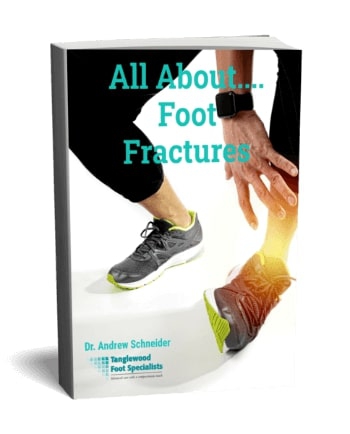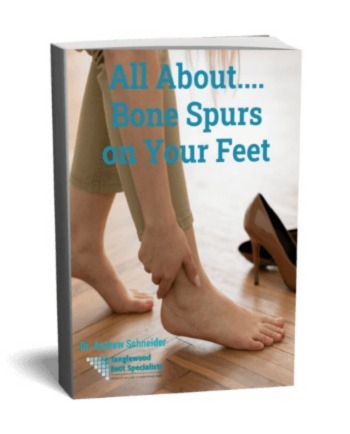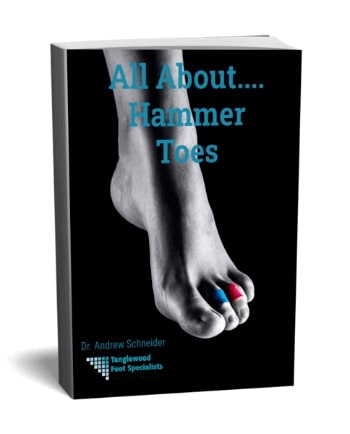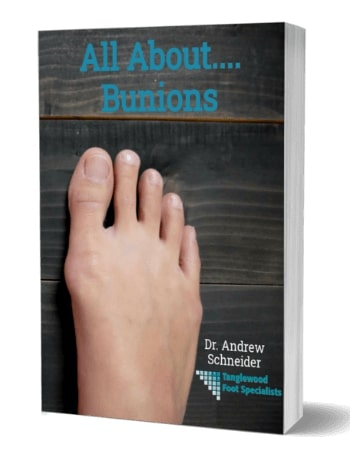 Most people don’t want to hear the word “surgery.” In fact, the goal in life is to avoid surgery whenever possible. There are times in my practice that I’ll have to tell you that foot surgery is the best option.
Most people don’t want to hear the word “surgery.” In fact, the goal in life is to avoid surgery whenever possible. There are times in my practice that I’ll have to tell you that foot surgery is the best option.
I don’t take recommending foot surgery lightly. I only suggest foot surgery when:
- We have tried all reasonable conservative treatment. That treatment has not improved your condition.
- You are in pain and surgery will resolve that pain.
- The surgery is not being done for cosmetic reasons. Your feet are too important for taking that risk.
We make the decision for surgery together. When we have that discussion, I’ll make sure to be upfront about the things that will most directly affect you.
- I’ll make sure you know how much time, if any, you need to take off of work.
- We’ll discuss if you can bear weight on the foot.
- I’ll let you know if you can safely drive during the postoperative course.
- I’ll give you the time frame to when sutures are removed.
- We’ll discuss when I expect you will be able to return to regular shoes.
- I’ll also let you know when you should be able to be more active and exercise again.
Surgery is a hard decision. I do my elective surgeries at an outpatient surgical center. This provides the best experience for you. The good news is that the center I use is in-network. They accept most commercial insurance plans and Medicare. If you think that you have a condition that may require surgery, contact us for an immediate appointment. We'll discuss your situation in detail and come up with the best treatment plan.
Some of the More Common Foot Surgeries I Do Include:
Bunion Surgery
What is a Bunion?
 A bunion is a bump on the side of the great toe joint. It is also possible to get a bunion at the 5th toe joint. That is called a tailor’s bunion or a bunionette. A bunion forms when the metatarsal bone rotates and displaces. This is what causes the bump on the side of the foot. Because of this shifting, it also causes the great toe to push against the second toe.
A bunion is a bump on the side of the great toe joint. It is also possible to get a bunion at the 5th toe joint. That is called a tailor’s bunion or a bunionette. A bunion forms when the metatarsal bone rotates and displaces. This is what causes the bump on the side of the foot. Because of this shifting, it also causes the great toe to push against the second toe.
A bunion can be painful for two reasons. One, the joint becomes misaligned. This causes the movement of the great toe to become restricted and painful. Second, the bump on the side of the foot can rub against shoes and become painful.
How Does Bunion Surgery Work?
Surgery to correct a bunion involves the repositioning of the metatarsal bone. By realigning the bone, it will make the joint flow more freely. It will also eliminate the bump on the side of the foot.
There are a number of procedures to correct a bunion. Dr. Schneider decides the procedure right for you. He does this by evaluating your foot and reviewing the x-rays. The procedure is done under general anesthesia. You may be able to bear weight on your foot immediately after the surgery. It all depends on the procedure performed. If so, you’d have to wear a postoperative shoe or boot when putting weight on your foot.
What is the Recovery for Bunion Surgery?
The recovery from bunion surgery depends on the procedure performed. In most cases, you’ll be able to bear weight on your foot immediately after surgery. In other cases, you may need crutches or a knee scooter to keep pressure off of your foot. We’ll discuss this in our preoperative visit.
The stitches will come out in approximately two weeks after the surgery. You usually can get back into an athletic shoe at 4 weeks after surgery. You can return to activity and exercise between 8 and 12 weeks after surgery.
Hammer Toe Surgery
What is a Hammer Toe?
 A hammer toe is a deformity of the toe when it buckles. This makes the knuckle of the toe more prominent. It happens when the mechanics of how the toes functions is not balanced. The pain from a hammer toe occurs when the toe presses against the shoes. This can cause a corn to form and can become quite painful.
A hammer toe is a deformity of the toe when it buckles. This makes the knuckle of the toe more prominent. It happens when the mechanics of how the toes functions is not balanced. The pain from a hammer toe occurs when the toe presses against the shoes. This can cause a corn to form and can become quite painful.
How Does Hammer Toe Surgery Work?
Surgery to correct a hammer toe involves removing a small piece of bone at the joint of the toe. This opens up the space in the joint and allows the toe to sit flat. For toes that are very contracted, there may be a pin in the toe as you heal. For particularly bad hammer toes, an implant is used. This helps to maintain the correction from the surgery.
What is the Recovery for Hammer Toe Surgery?
After a hammer toe surgery, you are able to bear weight on your foot immediately after the surgery. You will be wearing a surgical shoe during recovery. You are able to return to athletic shoes once the stitches come out and the pin is removed. This occurs in about three weeks. A return to other types of shoes is dependent on the amount of swelling in your toes.
Morton’s Neuroma Excision Surgery
What is a Morton’s Neuroma?
 A Morton’s neuroma is an inflamed and enlarged section of a nerve in the ball of your foot. The pressure of the metatarsal bones causes pressure on the nerve. The nerve responds by becoming inflamed and panful. You may particularly find it to be painful when you’re wearing tight shoes. These press the bones together and put more pressure on the nerve.
A Morton’s neuroma is an inflamed and enlarged section of a nerve in the ball of your foot. The pressure of the metatarsal bones causes pressure on the nerve. The nerve responds by becoming inflamed and panful. You may particularly find it to be painful when you’re wearing tight shoes. These press the bones together and put more pressure on the nerve.
How Does Morton’s Neuroma Excision Surgery Work?
The surgery to remove a Morton’s neuroma is straight forward. An incision is made over the inflamed nerve. Once it is identified, I remove the entire neuroma, which is a thickened bundle of nerves. Done under general anesthesia, it is a relatively quick surgery. It often lasts less than 30 minutes.
What is the Recovery for Morton’s Neuroma Excision Surgery?
You will be able to bear weight immediately after the surgery to remove a Morton’s neuroma. Once the sutures are removed in 2-3 weeks, you are able to return to regular shoes. You may then return to activity and exercise based on your level of discomfort.
Repair of Displaced Foot Fractures
![Houston podiatrist and foot surgeon recommends surgery for displaced foot fractures]() What is a Displaced Foot Fracture?
What is a Displaced Foot Fracture?
Sometimes something happens that causes a bone in your foot to break. Even though the bone breaks, it can stay in a good position. When this is the case, it will typically heal with immobilization. Other times, however, the bone fragments deviate and no longer line up. That’s when surgery is necessary.
How Does Surgery for Displaced Foot Fractures Work?
Surgery for a displaced foot fracture allows me to reposition the bone fragments. It fits back together like a puzzle. The goal is to get the bone back in good alignment. I’ll then use a combination of surgical plates and screws to maintain the correction. Usually, the plates and screws stay in the foot forever. Some people prefer it be removed once the bone is healed.
What is the Recovery for Surgery for Displaced Foot Fractures?
A surgical repair of a foot fracture can be fragile. Because of this, you’ll start off in a splint after surgery and will be non-weightbearing on the foot. You can use either crutches or a knee scooter to get around. After the initial healing phase, you’ll transition into a fracture boot to bear weight. You’ll likely stay in the boot until about eight weeks after the surgery. In most cases you can transition back to tennis shoes at that point. You’ll be able to start exercising at about 12 weeks after the surgery.
Heel Surgery for Heel Spurs and Plantar Fasciitis
What are Heel Spurs and Plantar Fasciitis?
 Plantar fasciitis is the most common cause of heel pain. It is an inflammation of the plantar fascia ligament where it attaches to the heel bone. When the ligament pulls on the bone when you walk, the bone can react and form a heel spur. A heel spur is a protrusion of bone on the bottom of the heel bone. Usually, the heel spur is not causing the pain.
Plantar fasciitis is the most common cause of heel pain. It is an inflammation of the plantar fascia ligament where it attaches to the heel bone. When the ligament pulls on the bone when you walk, the bone can react and form a heel spur. A heel spur is a protrusion of bone on the bottom of the heel bone. Usually, the heel spur is not causing the pain.
There are many conservative treatments for this condition. Some of these include anti-inflammatory medication, custom orthotics, and stem cell injections. When conservative therapy is exhausted, we may then discuss surgery.
How Does Heel Surgery Work?
The goal of heel surgery is to stop the pull of the plantar fascia ligament on the heel bone. To accomplish this, a small incision is made on the side of the heel. The plantar fascia is then released from the heel bone. If there is a heel spur, I’ll remove that too. The surgery is done under general anesthesia and takes about 45 minutes in total.
What is the Recovery for Heel Surgery?
In most cases, you’ll be able to bear weight on your foot immediately after surgery. You’ll be wearing a surgical shoe for about three weeks after the surgery. At that time, you’ll be able to return to tennis shoes. You’ll be able to return to exercise once any discomfort and swelling has resolved.
During the surgery, the plantar fascia ligament is released. Releasing this ligament causes mechanical instability. For that reason, we must support your foot with a custom orthotic afterwards. Dr. Schneider will evaluate you for these custom-made insoles. This usually occurs three months after surgery. If you were already wearing custom orthotics before the surgery, you won't need new ones after.
We’re Happy to See You for a Second Opinion
You may have visited with another doctor who recommended foot surgery. You may be wondering if foot surgery is the right choice. We see patients every day who come in for a second opinion for foot surgery. I start from scratch. I learn about your condition and everything you have done so far. That will give me enough information to know if there is more treatment to pursue before surgery. I’ll also be honest if I agree with your original doctor and foot surgery is in your best interest.
A second opinion never hurts. If nothing else, you’ll get peace of mind that you’re doing the right thing. Foot surgery is a big step. You should make sure that it is the right choice for you.
Your Preoperative Visit Before Foot Surgery
Before your scheduled surgery, you will meet with Dr. Schneider in the office. We set this time for you to ensure that you understand what the surgical plan is. Our goal is for you to go into your surgical procedure with a clear mind. This visit is your time to ask questions and get any answers you need. We will also complete the surgical consent form and review the postoperative instructions.
Don’t Let the Thought of Foot Surgery Stop You from Coming into the Office
Many times, my patients delay coming to the office because they are sure that they need surgery. Most of the time they end up surprised that there are other options to pursue. Surgery is rarely my first suggestion. As I said before, surgery is a last resort for when conservative care doesn’t solve the problem.
You may be suffering with foot pain and are concerned that surgery is the only answer. Give me a chance to evaluate your condition. We can then discuss an appropriate treatment plan. I can’t say that you absolutely won’t need surgery. I can say that most of my patients don’t need surgery. They’re able to get back to full activity with no pain. But if you do need foot surgery, we’ll walk you through it step by step.

 What is a Displaced Foot Fracture?
What is a Displaced Foot Fracture?
















